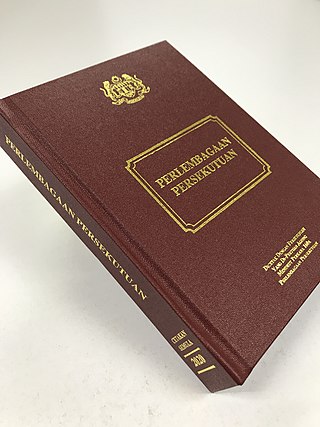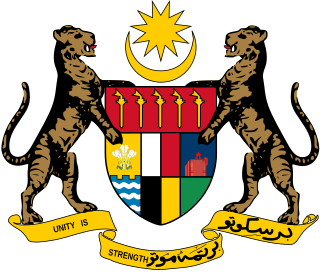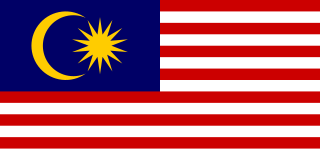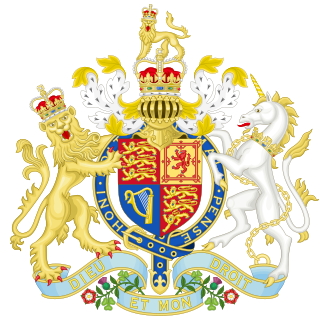Related Research Articles

East Malaysia, or the Borneo States, also known as Malaysian Borneo, is the part of Malaysia on and near the island of Borneo, the world's third-largest island. East Malaysia comprises the states of Sabah, Sarawak, and the Federal Territory of Labuan. The small independent nation of Brunei comprises two enclaves in Sarawak. To the south and southeast is the Indonesian portion of Borneo, Kalimantan. East Malaysia lies to the east of Peninsular Malaysia, the part of the country on the Malay Peninsula. The two are separated by the South China Sea.

The Federal Constitution of Malaysia, which came into force in 1957 as the Constitution of the Federation of Malaya and was amended in 1963 to form the Constitution of Malaysia, is the supreme law of Malaysia and contains a total of 183 articles. It is a written legal document influenced by two previous documents, the Federation of Malaya Agreement 1948 and the Independence Constitution of 1957. The Federation was initially called the Federation of Malaya and it adopted its present name, Malaysia, when the states of Sabah, Sarawak and Singapore became part of the Federation. The Constitution establishes the Federation as a constitutional monarchy, having the Yang di-Pertuan Agong as the Head of State with largely ceremonial roles. It provides for the establishment and organisation of three main branches of the government: the bicameral legislative branch called the Parliament, which consists of the House of Representatives and the Senate ; the executive branch led by the Prime Minister and his Cabinet Ministers and the judicial branch headed by the Federal Court.
The states and federal territories of Malaysia are the principal administrative divisions of Malaysia. Malaysia is a federation of 13 states (Negeri) and 3 federal territories.
The Constitution of the Republic of Singapore is the supreme law of Singapore. A written constitution, the text which took effect on 9 August 1965 is derived from the Constitution of the State of Singapore 1963, provisions of the Federal Constitution of Malaysia made applicable to Singapore by the Republic of Singapore Independence Act 1965, and the Republic of Singapore Independence Act itself. The text of the Constitution is one of the legally binding sources of constitutional law in Singapore, the others being judicial interpretations of the Constitution, and certain other statutes. Non-binding sources are influences on constitutional law such as soft law, constitutional conventions, and public international law.

Malaysian nationality law details the conditions by which a person is a citizen of Malaysia. The primary law governing nationality requirements is the Constitution of Malaysia, which came into force on 27 August 1957.

The Sedition Act 1948 in Malaysia is a law prohibiting discourse deemed as seditious. The act was originally enacted by the colonial authorities of British Malaya in 1948 to contain the local communist insurgence. The act criminalises speech with "seditious tendency", including that which would "bring into hatred or contempt or to excite disaffection against" the government or engender "feelings of ill-will and hostility between different races". The meaning of "seditious tendency" is defined in section 3 of the Sedition Act 1948 and in substance it is similar to the English common law definition of sedition, with modifications to suit local circumstances. The Malaysian definition includes the questioning of certain portions of the Constitution of Malaysia, namely those pertaining to the Malaysian social contract, such as Article 153, which deals with special rights for the bumiputra.

The 20-point agreement, or the 20-point memorandum, is a list of 20 points drawn up by North Borneo, proposing terms for its incorporation into the new federation as the State of Sabah, during negotiations prior to the formation of Malaysia. In the Malaysia Bill of the Malaysia Agreement some of the twenty points were incorporated, to varying degrees, into what became the Constitution of Malaysia; others were merely accepted orally, thus not gaining legal status. The 20-point agreement often serves as a focal point amongst those who argue that Sabah's rights within the Federation have been eroded over time.
The law of Malaysia is mainly based on the common law legal system. This was a direct result of the colonisation of Malaya, Sarawak, and North Borneo by Britain between the early 19th century to the 1960s. The supreme law of the land—the Constitution of Malaysia—sets out the legal framework and rights of Malaysian citizens.

Tan Sri Datuk Amar Stephen Kalong Ningkan was a Malaysian politician who served as the first Chief Minister of Sarawak from 1963 to 1966.
The 1966 Sarawak constitutional crisis took place in the state of Sarawak, Malaysia from 1965 to 1966. This crisis was started by a group of politicians who were dissatisfied towards Stephen Kalong Ningkan's leadership as chief minister. Ningkan was later removed from the chief minister post by the Governor of Sarawak in June 1966. However, Ningkan was reinstated by the High Court in early September 1966. He was ousted from the chief minister office for the final time at the end of September 1966 and was replaced by Tawi Sli as the new chief minister. It was widely believed that the ouster of Ningkan was a result of interference by the Malaysian federal government due to him being a strong advocate of greater state autonomy.

The Malaysia Agreement, or the Agreement relating to Malaysia between United Kingdom of Great Britain and Northern Ireland, Federation of Malaya, North Borneo, Sarawak and Singapore (MA63) was a legal document which agreed to combine North Borneo (Sabah), Sarawak, and Singapore with the existing states of Malaya, the resulting union being named Malaysia. Signed in London, United Kingdom, the agreement has been in effect since 16 September 1963; Singapore was subsequently expelled from Malaysia not long after this agreement, becoming a sovereign state on 9 August 1965.

The Malaysia Act 1963 was an act of Parliament of the United Kingdom. It came into operation on 31 July 1963.

The Proclamation of Malaysia was a statement, written in English and Malay, that declared the merger of the Federation of Malaya with the State of Singapore and the British crown colonies of North Borneo and Sarawak into the new Federation of Malaysia, following the enactment of the Malaysia Agreement and the Malaysia Act 1963 that July. The merger came into effect on 16 September 1963, and the proclamation was delivered on that date by Prime Minister Tunku Abdul Rahman in the Stadium Merdeka in Kuala Lumpur.

The Malaysia Bill is an annex of the Agreement relating to Malaysia between United Kingdom of Great Britain and Northern Ireland, Federation of Malaya, North Borneo, Sarawak and Singapore. It gave effect to the Agreement where that the British colonies of North Borneo, Sarawak and the State of Singapore should be federated with the existing States of the Federation of Malaya and the name of the federation should be Malaysia, and the Federal constitution wherewith to amend and adopt the Constitution of the Federation of Malaya so as to provide for the admission of those States. it adopted its present name, the name of the Constitution of the Federation of Malaya should be changed into Constitution of Malaysia.

The 18-point agreement, or the 18-point memorandum, was a purported list of 18 points drawn up by Sarawak, proposing terms to form Malaysia, during negotiations prior to the creation of the new federation in 1963. Unlike the Sabah's 20-point memorandum whose authors are known and well documented, no such details have been produced for the so-called Sarawak 18-points memorandum.

The premierof Sarawak is the head of government of the Malaysian state of Sarawak. The premier is appointed by the Yang di-Pertua Negeri (Governor) of Sarawak. The premier is also the leader of the political party or coalition that secures a majority in the Sarawak State Legislative Assembly.
The 1941 constitution of Sarawak is the first known written constitution in the Raj of Sarawak in Borneo. Written in the English language, the constitution was proclaimed by the third White Rajah of Sarawak, Charles Vyner Brooke on 24 September 1941, which ends the century of sole sovereignty of Brooke's rule and for the people of Sarawak to their own constitutional government.

On 4 April 2019, a bill proposing an amendment to the Constitution of Malaysia was tabled in the Dewan Rakyat of the Parliament of Malaysia. The bill proposes to amend Article 1(2) so as to restore the status of the two East Malaysian states of Sabah and Sarawak according to the original content of Malaysia Agreement that was signed in 1963.
The second Sarawak district council elections was held in 1963. The results of the election was announced from 18 to 25 June 1963. A total of 185,000 voters cast votes in this election, and a total of 998 candidates were vying for 429 district council seats in Sarawak.

The Constitution (Amendment) Act 2022 amended the Constitution of Malaysia to restore Sabah and Sarawak as equal partners to Malaya in Malaysia. This was intended to give effect to the Malaysia agreement of 1963. It was passed unanimously by the Dewan Rakyat on 14 December 2021 and came into effect after receiving royal assent on 11 February 2022.
References
- ↑ . 1963 – via Wikisource.
- ↑ "The Constitution of the State of Sarawak (until Article 50)". Suruhanjaya Perkidmatan Awam Sarawak (Sarawak public service department). Retrieved 19 May 2023.
- 1 2 3 4 Awang Mahadil (2014). The Relationship between Federal System of Malaysia And The Special Sovereign Rights Of Sarawak State (Dissertation Paper 2014, 1st Class) (Bachelor of Laws thesis). Aberystwyth University. doi:10.13140/2.1.5113.5048.
- 1 2 3 4 5 6 7 8 9 Porritt, Vernon L (2007). "Constitutional change in Sarawak 1963-1988: 25 years as a state within the federation of Malaysia". Borneo Research Bulletin. 38: 159–171. Archived from the original on 6 April 2023. Retrieved 19 April 2023.
- ↑ Faisal, S Hazis (2012). Domination and Contestation: Muslim Bumiputera Politics in Sarawak. Institute of Southeast Asian Studies. p. 86. ISBN 9789814311588.
Negri is empowered to make provisions for regulating Islamic affairs...
- ↑ "The Constitution of the State of Sarawak (1981 edition, until Article 24)" (PDF). Catholic Lawyers Society. Attorney-general's chambers, Kuching. Archived from the original (PDF) on 9 June 2021. Retrieved 20 May 2023.
- 1 2 "MA63 amendments passed". The Borneo Post. 22 July 2022. Archived from the original on 28 January 2023. Retrieved 7 June 2023.
- ↑ Chia, Jonathan (19 October 2016). "All round aye from Sabah, Sarawak". The Borneo Post. Archived from the original on 19 October 2016. Retrieved 20 October 2016.
- ↑ Ling, Sharon. "Historic Kuching post office among 52 plots of land returned to S'wak, says Premier". The Star (Malaysia). Archived from the original on 20 July 2023. Retrieved 23 July 2023.